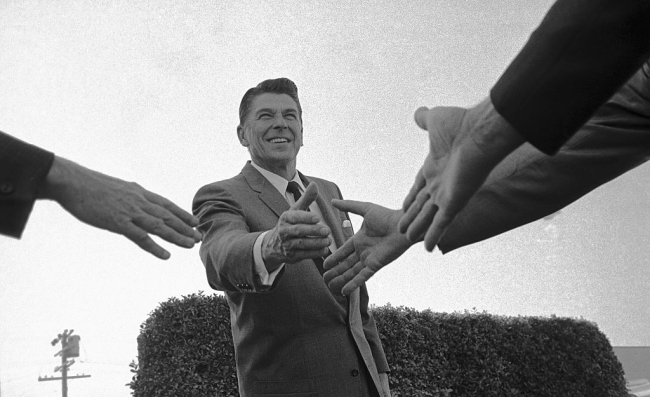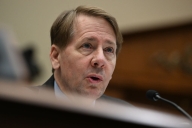You have /5 articles left.
Sign up for a free account or log in.

Ronald Reagan campaigning for the California governorship, which he won in 1966.
Bettmann/Contributor via Getty Images
Pundits on both sides of the aisle continue to debate the merits of President Biden’s plans to cancel student debt. But no matter which side of the debate you fall on, it’s hard to argue with the fact that canceling up to $20,000 in student debt will not fix the entrenched problems of higher education’s debt and tuition crises.
Student debt is a symptom of a philosophical shift in higher education’s purpose that began decades ago, in the 1960s. As explained by journalist Will Bunch in his new book, After the Ivory Tower Falls (HarperCollins), the election of Ronald Reagan as California governor in 1966 marked the end of the golden era of higher education in postwar America that was fueled by the GI Bill and rapid expansion of our higher education system. During this time, higher education was radically affordable, and, in Reagan’s state of California, tuition-free public higher education for state residents was a promise.
Reagan worked relentlessly during his gubernatorial tenure to end free public higher education: Bunch notes that while University of California’s lobbyists were able to fend off his plan to impose tuition, Reagan “got creative” and pushed for “ever-higher” student registration fees that, by the time he left office, “made a mockery of the state’s no-tuition pledge.” He also succeeded in changing the way his constituents thought about higher education when he announced in 1967 that “taxpayers shouldn’t subsidize intellectual curiosity”—the exact opposite of the postwar philosophy that higher education was a public good that benefited our country as a whole, even for those who never attended.
The rest of America soon adopted Reagan’s perspective, as college tuition rose and the federal government passed legislation to expand student loan eligibility and limits. We now witness a $1.7 trillion student debt crisis and runaway tuition costs—both a direct result of our philosophical shift in what higher education is for.
The cost of college today is economically too high, but there is another—though less tangible—cost of today’s high tuition prices: the loss of intellectual curiosity. By approaching higher education primarily as a means to pursue job training at scale, for which students should be responsible for paying the bulk of the costs, we have successfully stifled the notion of learning for learning’s sake—and made doing so unaffordable to most. Instead, learning must be tied to tangible economic outcomes; if it isn’t, then a student didn’t get a “return on their investment.”
We see the consequences of killing intellectual curiosity everywhere in our higher education system today: The cutting of programs in liberal arts disciplines. The rise of credentialism. The booming college-prep industry and college rankings manipulations.
And, to be honest, most of these outcomes are rational reactions to the type of higher education system that was made to train employees rather than develop intellectually curious, innovative and free thinkers. If a student needs to pay tens of thousands of dollars to attend college, you better believe they will do what they can to get into the highest-ranking college possible and demand they get a job with a high enough salary to pay down their debt after they graduate—ensuring they get the best return on their investment. If employers continue to demand college degrees for entry-level jobs that previously did not require one, you better believe students will do what they need to quickly and cheaply get a whatever credential an employer demands.
Higher ed is not short on efforts to fix its problems. However, many of the solutions are still reinforcing the job-training model of higher education. For example, the think tank Third Way is challenging U.S. News’ rankings by ranking institutions on economic mobility. It’s helpful to students to know which institutions will give them the best return on investment, but such a solution still placates the system. Similarly, loan forbearance and loan cancellation are just Band-Aids for the tuition crisis. Without radical investment to increase federal funding and bring tuition costs down, the fix provides no incentive for institutions to change. And the rise of nondegree pathways to get folks the credentials they need to get hired just reinforces the higher-ed-as-job-training philosophy.
The real cost of college today goes beyond the trillions of dollars in student loans; it’s what we have stolen from our students and our society. Our country’s narrow focus on the job-training philosophy of higher ed robs students of the equal opportunity to pursue intellectual curiosity, free thinking and learning for learning’s sake. And it robs our society of the cultural and intellectual diversity provided by those students, and the potential innovations that curious free thinkers produce. Instead, we have a higher education philosophy that has saddled students with insurmountable debt and contributed to unrelenting class inequality and the political fracturing of our country.
The solution is no less than a 180-degree shift in philosophy to view higher education as a public good—a worthwhile investment as a country to educate our citizenry and produce curious, innovative and free thinkers. As John Warner explains in Sustainable. Resilient. Free. (Belt Publishing, 2020), we must radically invest in public higher education to bring costs as close to zero as possible and refocus our institutions on the education of students. We need to change the incentive structure of college operations to incentivize liberal education, teaching excellence and intellectual curiosity. It’s the only way to get out of the cost crisis we find ourselves in.
The student debt crisis won’t be solved without a shift to higher education as a public good where, yes, taxpayers do, in fact, subsidize intellectual curiosity. The costs are too high if we don’t.








